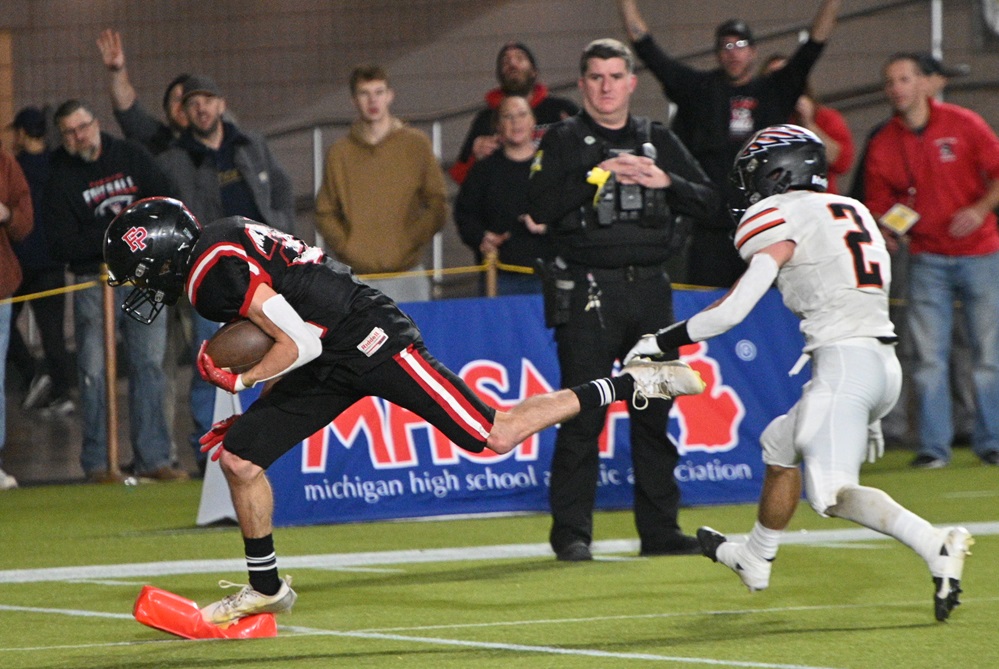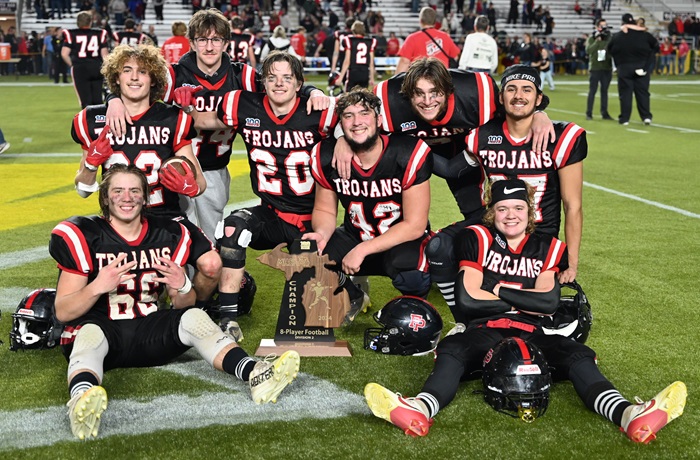
Haslett Saving Big Hits for Game Time
August 16, 2016
By Geoff Kimmerly
Second Half editor
HASLETT – The sound of cleats on pavement. He and his teammates, hand in hand, walking toward the field together minutes before kickoff. Manowar’s “Heart of Steel” ringing in their ears from a few minutes before.
 Justin Kuchnicki gave himself goose bumps Monday describing Haslett’s weekly pregame ritual, which the senior lineman will take part in again beginning Aug. 26 when the Vikings open this season against Remus Chippewa Hills.
Justin Kuchnicki gave himself goose bumps Monday describing Haslett’s weekly pregame ritual, which the senior lineman will take part in again beginning Aug. 26 when the Vikings open this season against Remus Chippewa Hills.
They’ll certainly be revved up – and especially to lay some big hits after saving them up during three weeks of non-collision practices.
Haslett has one of the most successful football programs in the Lansing area, with two trips to MHSAA championship games and 14 playoff appearances total over the last 18 seasons. The Vikings finished 6-4 a year ago against a schedule featuring four eventual playoff teams.
The program also might be the first in all of Michigan high school football to fully eliminate full-speed hitting at practice, something Haslett has moved toward over the last few seasons before longtime coach Charlie Otlewski decided to knock it out of his practice plans completely this fall in large part to keep his players healthier for when it matters most.
“It gives you the edge when it gets to game day. You practice all week and you’re not really hitting or doing anything like that, and you get to game day … and everyone’s ready to just go out there and fly around and make plays,” Kuchnicki said. “You’re not really worried about kinks and stuff in your body that you’d have from practices, so you just go out there and lay it on the line.”
Friday was the first day Michigan high school players were allowed to practice in full pads. Storms drenched mid-Michigan that afternoon, so Haslett’s first day in full gear was Monday. And from a distance, it sounded like any other full-contact practice with the normal hoots and hollers and smacking of pads.
But on closer look, it was anything but. Lineman worked against blocking dummies on a sled or teammates holding hand pads. When the offense came together to run plays, linemen blocked against overturned plastic trash barrels. On the opposite end of the field, subvarsity players worked on defensive pursuit angles but again without hitting. Under a set of uprights laid an old gymnastics mat used to soften the fall during tackling drills, which players again did against standup dummies instead of their teammates.
Reducing collisions – that is, live, game-speed, player-vs.-player hitting – remains the focus of most conversations on health and safety in football. Much of the discussion is centered on reducing concussions, and MHSAA rules changes that took effect beginning with the 2014 season limit teams to one practice per day during the preseason (when teams frequently practice twice) where collisions can take place. During the regular season, teams can have collisions during practice only two days per week.
 Otlewski – who formerly coached St. Ignace from 1990-93 before taking over at Haslett in 1994 – said his practices used to follow what could be considered a traditional after-school plan: individual position drills for an hour or more followed by 11-on-11 full contact team practice for 30-40 minutes, twice a week.
Otlewski – who formerly coached St. Ignace from 1990-93 before taking over at Haslett in 1994 – said his practices used to follow what could be considered a traditional after-school plan: individual position drills for an hour or more followed by 11-on-11 full contact team practice for 30-40 minutes, twice a week.
But a handful of reasons, chiefly the desire to avoid injuries, started his program on a different path five years ago.
“Nobody wants injuries, but you surely don’t want them in practice. Then the concussion thing started to happen. (But) we didn’t do it because of concussions; we did it because of general overall injuries,” Otlewski said.
“If we lose a guy in Thursday’s scrimmage, or next Thursday in a game, OK, that’s football. But what we don’t want to do is lose someone in practice, because that seems unnecessary.”
The initial changes Haslett began to make to practices that fall of 2011 became drastic two years later, when he and his staff went to a different practice model completely. The Vikings now break every practice into 10-minute sessions alternating between team time and position drills, so position coaches can work with players individually before and after seeing how they perform when all 11 are running plays together.
This new breakdown brought the amount of player-on-player contact at practice down significantly as much more time was dedicated to learning proper footwork, blocking and tackling techniques and other fundamentals. Players on Monday worked at 50-percent speed, at most, against teammates either in front of them and also not moving at game speed, or against others holding pads and dummies.
The last two seasons, the only full-contact session during practices came during preparation for goalline situations; Otlewski and his staff decided to eliminate those this fall as well.
“We’re OK with a certain level (of contact). But we never want to go on the ground; we always want to stay up,” he said. “We want to go fast enough so where we have to use the perfect technique to get there footwork-wise. But we’re trying to eliminate the physicality part.”
To be clear, eliminating all collisions/contact is not required by the MHSAA. And there are probably more than a few in the coaching fraternity who would think Haslett is making a massive mistake.
But the Vikings’ no-contact strategy follows a way of thinking made popular in part by coaches like Dartmouth College’s Buddy Teevens, whose team hasn’t tackled during practices in six years. The Ivy League as a whole adopted a policy of no tackling in practice for the regular season beginning this fall.
 Otlewski said teaching to tackle without contact allows his players to practice the same technique-building drills during four-player offseason workouts, his team’s no-pads summer camp and then while wearing pads during the season. His defense doesn’t face a live offense during the week, but he doesn’t think his players lose out because they can gain just as much from watching film and working on pursuit angles and recognizing formations. Same goes for his offense, which can still practice skill work and the passing game full-speed while lineman go half-speed working on footwork and blocking technique.
Otlewski said teaching to tackle without contact allows his players to practice the same technique-building drills during four-player offseason workouts, his team’s no-pads summer camp and then while wearing pads during the season. His defense doesn’t face a live offense during the week, but he doesn’t think his players lose out because they can gain just as much from watching film and working on pursuit angles and recognizing formations. Same goes for his offense, which can still practice skill work and the passing game full-speed while lineman go half-speed working on footwork and blocking technique.
And he sees 37 players on his varsity roster, with that total remaining consistent over the last many seasons – while three opponents on this year’s schedule don’t have junior varsities and a fourth won’t field a freshman team.
His players three seasons ago didn’t really like the idea of not hitting in practice at first. But they’ve since bought in. He hasn’t heard a ton from parents either way; but he taught a class on football for local moms over the winter, and they seemed to like the idea as well.
“On one hand, I’m a little apprehensive,” Otlewski said. “OK, we haven’t gone full go. Is there a difference all of a sudden when it’s live Thursday against (Grand Rapids) Christian? Are we going to be up to speed?
“I think I still worry about that a little bit. But once we get into it, it’s fine.”
Kuchnicki is just as confident. Contact doesn’t bother this guy. He’s 6-foot-6 and in the neighborhood of 320 pounds. Sure, he’d love to have one contact practice this year so he and his teammates can back up some of the trash-talking they do to each other on the field.
But he’s fine with saving his biggest hits for opponents – and especially those who might think Haslett won’t be prepared for a physical game.
“They’d probably think we’re soft,” Kuchnicki said. “But when it comes game day, they change their minds instantly. I’ll tell you that.”
 Geoff Kimmerly joined the MHSAA as its Media & Content Coordinator in Sept. 2011 after 12 years as Prep Sports Editor of the Lansing State Journal. He has served as Editor of Second Half since its creation in Jan. 2012. Contact him at [email protected] with story ideas for the Barry, Eaton, Ingham, Livingston, Ionia, Clinton, Shiawassee, Gratiot, Isabella, Clare and Montcalm counties.
Geoff Kimmerly joined the MHSAA as its Media & Content Coordinator in Sept. 2011 after 12 years as Prep Sports Editor of the Lansing State Journal. He has served as Editor of Second Half since its creation in Jan. 2012. Contact him at [email protected] with story ideas for the Barry, Eaton, Ingham, Livingston, Ionia, Clinton, Shiawassee, Gratiot, Isabella, Clare and Montcalm counties.
PHOTOS: (Top) Haslett lineman work on blocking during Monday's practice. (Middle) Vikings coach Charlie Otlewski instructs his players on one of the team's blocking schemes. (Below) Backs work on the option with barrels serving as the defensive front.

Forest Park Meets Expectations, Adds to Tradition with 5th Championship
By
John Vrancic
Special for MHSAA.com
December 5, 2024
MARQUETTE — They came. They saw. They conquered.
 The Crystal Falls Forest Park Trojans did what they set out to do this season, earning their first MHSAA Finals title in seven years in a 42-20 triumph over the Morrice Orioles in the Nov. 30 8-player Division 2 championship game at Northern Michigan University’s Superior Dome.
The Crystal Falls Forest Park Trojans did what they set out to do this season, earning their first MHSAA Finals title in seven years in a 42-20 triumph over the Morrice Orioles in the Nov. 30 8-player Division 2 championship game at Northern Michigan University’s Superior Dome.
Forest Park sits fourth all-time with 15 championship game appearances over the 50 years of MHSAA Football Playoffs. This was the program’s first championship since winning Division 2 in 2017 and came after six straight seasons of reaching the postseason but losing during the first or second round.
“My brother (Kevin) and I been talking about this since we were little,” Trojans sophomore quarterback Vic Guiliani said. “When (Morrice) got within 35-20, we just had to keep our foot on the pedal. They responded very well, but we kept our composure.
“It’s crazy motivation. Every year you lose a lot of good seniors, but we still have the heart. We want to get back here.”
The victory enabled the Trojans to finish 12-1. Their only loss took place in a regular-season finale Oct. 25 when they dropped a 45-34 decision to Powers North Central.
That defeat cost Forest Park the Great Lakes Eight Conference West championship. But the Trojans stormed back to avenge it with a 34-12 win over the Jets two weeks later to clinch a Regional title.
“There were a lot of little things,” sophomore running back Dax Huuki recalled of the first North Central matchup. “That was our worst game of the season, but that was probably the best thing that happened to us. That was a nice little reality check, but we weren’t going to put up with it. Everyone on the team really wanted this. That’s what got us here. Our seniors told us what we needed to do and ‘we’re not going to take a play off.’ They held us accountable.”
 Forest Park’s successes in the championship game against Morrice were consistent with what the Trojans did well all season. Huuki ran 19 times for 136 yards and two touchdowns, finishing this fall with 162 carries, 1,560 yards and 22 scores on the ground. The team’s 291 rushing yards total for the game pushed the Trojans to 4,004 for the season – but Giuliani also completed all four of his passes for 60 yards, giving him 968 for the season and pushing the team total to an importantly complementary 1,049. Seniors Grayson Sundell (918 yards/18 TDs rushing) and Nick Stephens (11 TDs) were among other top runners for the Trojans.
Forest Park’s successes in the championship game against Morrice were consistent with what the Trojans did well all season. Huuki ran 19 times for 136 yards and two touchdowns, finishing this fall with 162 carries, 1,560 yards and 22 scores on the ground. The team’s 291 rushing yards total for the game pushed the Trojans to 4,004 for the season – but Giuliani also completed all four of his passes for 60 yards, giving him 968 for the season and pushing the team total to an importantly complementary 1,049. Seniors Grayson Sundell (918 yards/18 TDs rushing) and Nick Stephens (11 TDs) were among other top runners for the Trojans.
Seven players started on both sides of the ball, and holding Morrice to just 194 yards of total offense fell in line with the team’s average of 201 average yards allowed entering the game.
After giving up 45 points to North Central in Week 9, the Trojans gave up a combined 56 over four playoff games.
“We definitely felt the sting of losing in our last regular-season game,” Forest Park coach Brian Fabbri said. “Five turnovers and 10 penalties didn’t help.
“It feels great to be state champions. I know how it feels to walk off the field on the other side. I experienced that twice. It’s not a good feeling.”
Fabbri became the fourth coach in Forest Park history to win one of the program’s five overall championships. He also played on a pair of Trojans teams that finished Finals runners-up in 2004 and 2005.
He’ll graduate seven of the 23 players on the postseason roster, including also two-way starters Matthew Showers, Brody Starr, Nate Bradish and Kevin Giuliani. The 6-foot-5, 270-pound Giuliani had made the all-state second team as a junior and will continue as an offensive lineman at Michigan Tech.
“Expectations were very high,” Fabbri said. “Our senior leadership was amazing. They kept us in the game.”
 John Vrancic has covered high school sports in the Upper Peninsula since joining the Escanaba Daily Press staff in 1985. He is known most prominently across the peninsula for his extensive coverage of cross country and track & field that frequently appears in newspapers from the Wisconsin border to Lake Huron. He received the James Trethewey Award for Distinguished Service in 2015 from the Upper Peninsula Sportswriters and Sportscasters Association.
John Vrancic has covered high school sports in the Upper Peninsula since joining the Escanaba Daily Press staff in 1985. He is known most prominently across the peninsula for his extensive coverage of cross country and track & field that frequently appears in newspapers from the Wisconsin border to Lake Huron. He received the James Trethewey Award for Distinguished Service in 2015 from the Upper Peninsula Sportswriters and Sportscasters Association.
PHOTOS Forest Park’s Nik Stephens (22) gets to the pylon for one of his three touchdowns Nov. 23 at Northern Michigan University. (Middle) The Trojans’ seniors take a photo with the program’s fifth championship trophy. (Photos by Cara Kamps.)

